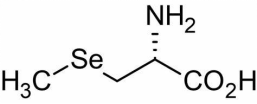L-Se-methylselenocysteine, CAS:26046-90-2
Time:2024-03-01 Hits:236

L-Se-methylselenocysteine structure diagram
Product info
CAS:26046-90-2
Molecule Weight: 182.09g/mol
Molecule Weight: 182.09g/mol
|
Product
|
Purity
|
Level
|
Packaging
|
|
L-Se-Methyl Selenocysteine
|
98%
|
Food Grade
|
5g 50g 100g
|
Product introduction
L-Se-methylselenocysteine (SMC) is an organic selenium compound resembling methionine, featuring a side chain with a methylseleno group. This compound, a derivative of Se-methylselenocysteine, demonstrates anti-tumor effects. As a naturally occurring organic selenium compound, methylselenocysteine is prevalent in plants like garlic, onions, and broccoli, offering potential antioxidant and chemopreventive activities.
SMC functions as an amino acid analog of cysteine, with a methylseleno group replacing the sulfur atom in cysteine. This unique composition allows SMC to bind to glutathione peroxidase, exerting antioxidant effects and showcasing significant preventive activity in animal models.
Selenium plays crucial physiological roles in the human body, contributing to antioxidant mechanisms, immune function enhancement, cardiovascular health protection, among others. SMC, with its distinctive attributes, demonstrates diverse biological functions. Research indicates its ability to ameliorate neuropathology and cognitive deficits in Alzheimer's disease models. It inhibits ERK1/2 signaling through ROS-dependent pathways, exhibiting anti-tumor activity in anaplastic thyroid cancer (ATC) cells. SMCs display potential in preventing various human diseases. Moreover, SMC has been found to regulate oxidative stress, maintain metal homeostasis, and modulate extracellular signal-regulated kinase (ERK) activation, ultimately improving Alzheimer's disease-related neuropathology and cognitive deficits. SMC treatment reverses the expression of proteins related to metabolism, synapses, and antioxidant proteins that are reduced in AD mice. These findings highlight the potential therapeutic value of SMC in addressing diverse diseases and conditions.
Product application
In the pharmaceutical industry,
SMC is extensively utilized due to its distinctive biological functions and safety profile. Its applications primarily encompass the following facets: Firstly, SMC is employed in the treatment of selenium deficiency, as selenium is a vital trace element for the human body, and its deficiency can lead to various diseases. Serving as an effective remedy, SMC can address selenium deficiencies and ameliorate symptoms in affected patients. Secondly, SMC exhibits the capability to inhibit the growth of tumor cells, making it valuable for preventing and treating various cancers, such as breast cancer and lung cancer. Clinical trials have explored SMC's potential in prostate cancer prevention. In the cardiovascular realm, SMC demonstrates antioxidant, anti-inflammatory, and hypolipidemic effects, mitigating the risk of cardiovascular diseases, including coronary heart disease, hypertension, and heart failure.
In the nutrition industry,
L-Se-methylselenocysteine serves as a nutritional supplement to preemptively combat cancer, cardiovascular diseases, neurodegenerative diseases, and more. Research indicates that SMC can impede tumor cell growth, lowering the risk of cancer; it can also reduce blood lipids and blood pressure, providing preventive measures against cardiovascular diseases. Additionally, SMC supports the growth and regeneration of nerve cells, proving beneficial in neurodegenerative conditions like Alzheimer's and Parkinson's disease, with potential preventive and therapeutic effects against conditions like Kinson's disease.
In the feed additive sector,
SMC finds application as a feed additive to enhance the performance and health of livestock and poultry, preventing selenium deficiency. Studies reveal that SMC can enhance egg production, egg weight, and feed conversion rate in broilers, as well as improve the growth rate and feed conversion rate in pigs. Furthermore, it contributes to a reduction in mastitis incidence in dairy cows.
